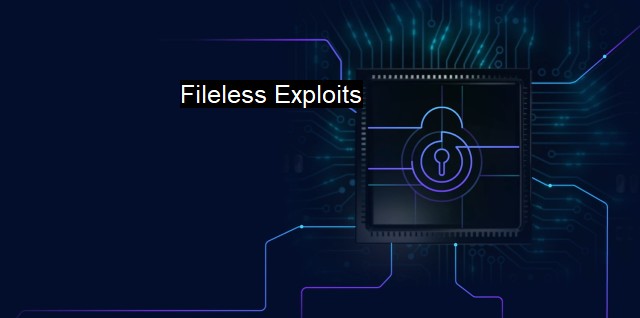What are Fileless Exploits?
Navigating the Dangers of Fileless Exploits: Understanding the Latest Cybersecurity Threats and Solutions
Fileless exploits are a specific category of cyber threats that use genuine applications and software typically present in operating systems to carry out their malicious actions. Unlike traditional malware that relies on explicit files or code to harm their targets, fileless exploits do not leave tangible traces which makes them harder to detect, and this heightened obfuscation positions them as a breed of high-risk cyber threats.Cybercriminals have found ways to bypass security defenses by exploiting legitimate tools included in most operating systems. An example particularly evident in windows-based systems is PowerShell, a powerful management framework that comes with the OS. PowerShell can execute a wide range of commands, and it's this inherent potency that makes it appealing to attackers.
Traditionally, an anti-virus program's modus operandi involves seeking out and identifying unusual files, monitoring their behavior, and using a committed database of recognized viruses to detect potential threats. since fileless exploits infiltrate and manipulate authorized tools within the system, many antivirus solutions hit a blind spot due to the lack of traditional signs of intrusion.
This doesn't mean there aren’t attempts to protect against fileless exploits. Sidestepping the malware detection challenge, focus swivels from malicious file detection to monitoring system activity and behavior abnormalities. An example of such an approach is Behavioral-based detection, which deals with understanding how legitimate users interact with their computer systems. Then, by leveraging machine learning algorithms and artificial intelligence, these systems can pinpoint activities outside of regular patterns and signal potential compromise.
So, how do fileless exploits work? Typically, an attack using fileless exploits begins with an innocent-looking email link or website visitor unsuspectingly click on. The link.aspx may redirect to a genuine-looking webpage that injects a script code into the computer’s RAM through the Internet browser. The code then resides in the RAM, deploying exploits that control system applications while leaving no traces on the disk.
One such instance is the use of macros in Word documents. While they are meant to make users' tasks more manageable by automating certain operations within plaintext, cybercriminals manipulate them to run harmful scripts when the document is opened. as the code is not saved on the disk but resides entirely on built-in OS tools, these attacks are inherently 'file-less' and, therefore, much more challenging to detect and combat.
In response, tech organizations are continuously trying to improve antivirus solutions with fileless malware in mind. For instance, hibernating a system can cause certain portions of fileless malware to be detected due to its dependence on residing in the memory of the computer. Advanced memory scanning is another solution, with antivirus companies now including this as part of their software offerings. strict access controls on tools, such as PowerShell, can also limit their potential misuse.
Still, to efficiently fight fileless exploits, companies need to develop a robust defense paradigm with a strong emphasis on user training. Phishing attacks are the most typical starting point for many fileless exploits, so teaching users about the dangers of unidentified emails and websites becomes particularly important. Other important practices can include regular patching and segregating network to restrict lateral movements of malware.
Fileless exploits exemplify the continuing evolution of cyber threats that aren't just challenging to detect but also have an enhanced potential for damage. The prospects of combating fileless malware pivot towards behavior-based practices and require organizations to reflect on their strategic approaches towards cybersecurity and beyond.

Fileless Exploits FAQs
What is a fileless exploit?
A fileless exploit is a type of cyber attack that does not involve the installation of malicious software on a victim's computer. Instead, the attack exploits vulnerabilities in legitimate software or uses built-in system tools to execute malicious code.How do fileless exploits evade detection by antivirus software?
Fileless exploits are more difficult for antivirus software to detect because they do not involve the creation of a malicious file. Instead, the code is executed in memory, making it more difficult for traditional antivirus programs to identify and stop the attack.What are some preventive measures against fileless exploits?
Some preventive measures against fileless exploits include keeping your software, firmware and operating system up-to-date, using anti-exploit tools, and running malware scans regularly. It's also important to educate employees about cyber threats and establish strong security protocols.What is the impact of a fileless exploit on an organization?
The impact of a fileless exploit on an organization can be severe, as these attacks often go undetected for extended periods of time, giving attackers more time to steal sensitive information, compromise systems, and cause damage. Organizations may suffer reputational damage, financial losses, and legal consequences as a result of a successful fileless exploit.| | A | | | B | | | C | | | D | | | E | | | F | | | G | | | H | | | I | | | J | | | K | | | L | | | M | |
| | N | | | O | | | P | | | Q | | | R | | | S | | | T | | | U | | | V | | | W | | | X | | | Y | | | Z | |
| | 1 | | | 2 | | | 3 | | | 4 | | | 7 | | | 8 | | |||||||